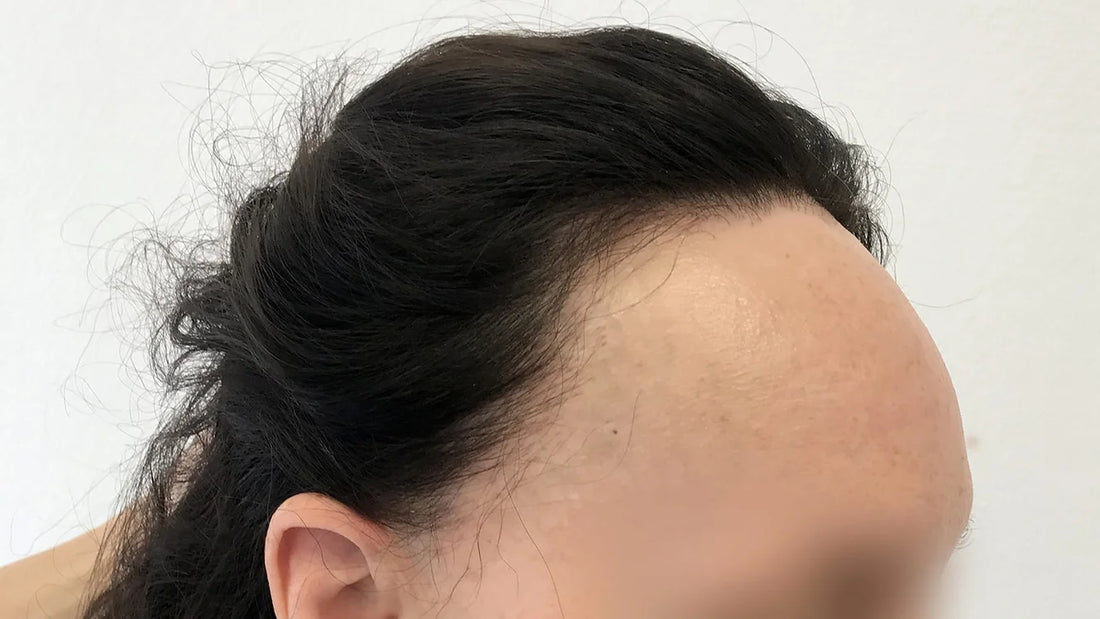
Frontale Fibroserende Alopecia
Delen
Frontale fibroserende alopecie (FFA) is een vorm van littekenalopecie waarbij haarverlies voornamelijk optreedt rond de voorste haarlijn en slapen. Deze aandoening resulteert vaak in een terugtrekkende haarlijn en kan, indien onbehandeld, leiden tot permanent haarverlies. De exacte oorzaak van FFA is onbekend, maar men vermoedt dat auto-immuunmechanismen een rol spelen, waarbij het immuunsysteem de haarzakjes aanvalt.
- Bij Vrouwen: FFA manifesteert zich meestal als een geleidelijke terugtrekking van de voorste haarlijn, vaak gepaard met verlies van wenkbrauwen.
- Bij Mannen: FFA komt minder vaak voor, maar kan toch leiden tot een aanzienlijke terugtrekking van de haarlijn en dunner wordend haar in het voorste gebied.
Genetische Oorsprong en Mechanismen van Frontale Fibroserende Alopecie
Frontale fibroserende alopecie is een relatief zeldzame aandoening die vaker voorkomt bij vrouwen dan bij mannen, vooral na de menopauze. Het kenmerkende verschijnsel is het geleidelijke terugtrekken van de haarlijn, wat ook de wenkbrauwen en andere lichaamsbeharing kan beïnvloeden.
Permanente haaruitval bij FFA wordt veroorzaakt door ontsteking die leidt tot littekenvorming van de haarzakjes, waardoor deze geen nieuw haar meer kunnen produceren. Dit littekenproces gaat meestal gepaard met een rode, ontstoken rand langs de haarlijn.
Begrip van de Rol van Ontsteking en de Haargroeicyclus
Bij FFA richt een ontstekingsproces zich op de haarzakjes, wat leidt tot fibrose (littekenvorming) en uiteindelijk de vernietiging van de haarzakjes. Deze ontsteking verstoort de normale haargroeicyclus en leidt tot permanent haarverlies in de getroffen gebieden.
Normale Haargroeicyclus
De haargroeicyclus omvat de gecoördineerde inspanning van haarwortels, haarzakjes, eiwitten, vitamines en voedingsstoffen om ongeveer elke vijf jaar nieuwe haren te produceren. Deze cyclus omvat:
- Groeifase: Haar groeit ongeveer vijf jaar.
- Overgangsfase: Het oude haar wordt uitgeduwd terwijl een nieuw haar zich vormt.
- Rustfase: Het oude haar wordt losjes in de hoofdhuid vastgehouden als 'dood materiaal'.
- Uitvalfase: Het oude haar valt uit en nieuw haar groeit ervoor in de plaats.
Haargroeicyclus en Frontale Fibroserende Alopecie
Bij mensen met FFA verkort het ontstekingsproces de groeifase en leidt tot de permanente vernietiging van haarzakjes. Dit resulteert in progressief en onomkeerbaar haarverlies in de aangetaste gebieden.
- Groeifase: Ontsteking verkort de groeifase en beschadigt de haarzakjes.
- Overgangsfase: Het oude haar wordt uitgeduwd, maar nieuw haar kan niet groeien door schade aan de haarzakjes.
- Rustfase: Het oude haar krijgt geen voeding meer, en nieuw haar wordt niet gevormd.
- Uitvalfase: Het oude haar valt uit en er groeit geen nieuw haar voor in de plaats.
Haarzakjes: Haarproductie
Elk haarzakje groeit een enkele haar. Gezonde haarzakjes produceren dikke, lange haren, terwijl ontstoken en verlittekende haarzakjes bij FFA dunne, korte haren of helemaal geen haar produceren.
Genetische Factoren bij Frontale Fibroserende Alopecie
Hoewel de exacte oorzaak van FFA niet volledig wordt begrepen, wordt aangenomen dat genetische aanleg en auto-immuunreacties een belangrijke rol spelen. De aanwezigheid van specifieke genetische factoren kan het risico op FFA vergroten, wat leidt tot een auto-immuunaanval op de haarzakjes.
Behandelingsopties: Ontsteking Beheren
De effectiviteit van behandelingen zoals TRIX Gamma, een voedingssupplement, is gebaseerd op het verminderen van ontstekingen en het ondersteunen van de gezondheid van haarzakjes. TRIX Gamma bevat ingrediënten die helpen ontstekingen te verzachten en een gezondere hoofdhuidomgeving bevorderen, wat mogelijk de progressie van FFA vertraagt.
Wat Gebeurt Er Als Ik Niets Doe?
Als u FFA heeft en ervoor kiest om niets te doen, zal uw haarverlies geleidelijk erger worden. Het haar wordt dunner en valt sneller uit, wat leidt tot steeds zichtbaardere kale plekken. Vroege behandeling geeft betere resultaten door ontstekingen te beheersen en bestaande haarzakjes te behouden.
Geschikt voor Alle Leeftijden?
Vroeg beginnen met behandeling kan het kaalheidsproces vertragen, maar zelfs oudere personen kunnen baat hebben bij supplementen. Jongere mensen kunnen echter langer profiteren door zichtbare kaalheid uit te stellen en langer gezonder haar te behouden.
Is Het Frontale Fibroserende Alopecie of Een Andere Haarconditie?
FFA herkennen is meestal eenvoudig vanwege het kenmerkende patroon van haarlijnterugtrekking en bijbehorende ontstekingen. Als u echter twijfelt, kan een dermatoloog uitsluitsel geven en helpen andere aandoeningen zoals androgene alopecia of telogeen effluvium uit te sluiten.
Conclusie
Het negeren van frontale fibroserende alopecie kan leiden tot aanzienlijk haarverlies en kale plekken. Het is essentieel om snel actie te ondernemen om haarverlies te vertragen of zelfs te stoppen. Medicatie en voedingssupplementen kunnen een effectieve oplossing bieden door ontstekingen te verminderen en de gezondheid van haarzakjes te ondersteunen. Als u merkt dat uw haar dunner wordt of twijfelt over de oorzaak van uw haarverlies, raden we u aan contact op te nemen met een arts of dermatoloog. Momenteel bieden wij geen supplementen die specifiek zijn afgestemd op FFA.

















